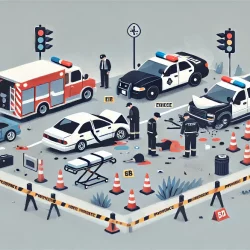Talk and Die Syndrome Explained
Introduction
Talk and die syndrome is a serious condition that can occur after suffering a head injury or head trauma in a motor vehicle accident. It describes a situation where a person has suffered a serious brain injury as a result of the crash, but despite the severity of the injury, the person appears "fine" and appears to be "acting normally."
Consequently, medical careis delayed or not sought at all.
Unfortunately, by the time a serious injury is realized, it is too late, and the person suddenly – and frequently without warning - dies.
Do you have a case if you suffered from this syndrome after a crash?
When you have lost a loved one to this personal injury after a crash, you should talk with an experienced brain injury lawyer as soon as possible. A brain injury lawyer will explore your legal options and rights to sue the negligent driver for pain and suffering compensation,money damages for medical expenses, and reimbursement for your lost wages your loved one would have earned.
How does a car crash cause this syndrome?
In a collision, the force of impact or the violent whipping back and forth of a person's head may throw the brain back and forth within the skull, causing the blood vessels that deliver blood to the brain to shear and rupture. When that happens, blood begins to pool between the brain and the skull. As the brain bleeds increasein size, it puts pressure on the brain, eventually damaging the brain and causing important functions of the brain to shut down, such as its control over breathing and cognitive function. While this slow but deadly process is unfolding, the injured person's outward appearance and behavior may – at least initially – continue to appear "normal" until the injury becomes too debilitating and/or fatal, hence the name "talk and die" syndrome.
How does this syndrome occur after a car accident?
In the case of this syndrome, the brain is injured or damaged in some way after an accident. This can occur when there's a blow to the head, causing concussion or traumatic brain injury (TBI) after a car accident. Without timely and proper medical care and treatment, death will result.
Concussions don't always produce symptoms immediately; they may not appear until hours later when you feel drowsy and have difficulty concentrating on the tasks at hand. One important thing to remember about concussions is that they must be treated by a medical professional because they can lead to permanent damage or death if left untreated!
Actress Natasha Richardson was a victim of talk and die syndrome
In 2009, actress Natasha Richardson was skiing with her family when she fell and struck her head. She did not appear to be injured. She was walking and talking. She said she felt fine. She even refused medical attention. However, later in the day, she experienced a headache severe enough that she went to the hospital. Tragically, she went into a coma and died. Her grieving family eventually learned that she had suffered from an untreated epidural hematoma, which involves bleeding within the skull that causes fatal, irrevocable neurological damage.
Conclusion
In order to protect yourself and your loved ones from talk and die syndrome, go to your doctor or to the hospital immediately if you suffer a head trauma or a head injury after being involved in an auto crash.
More to Read:
Previous Posts:




